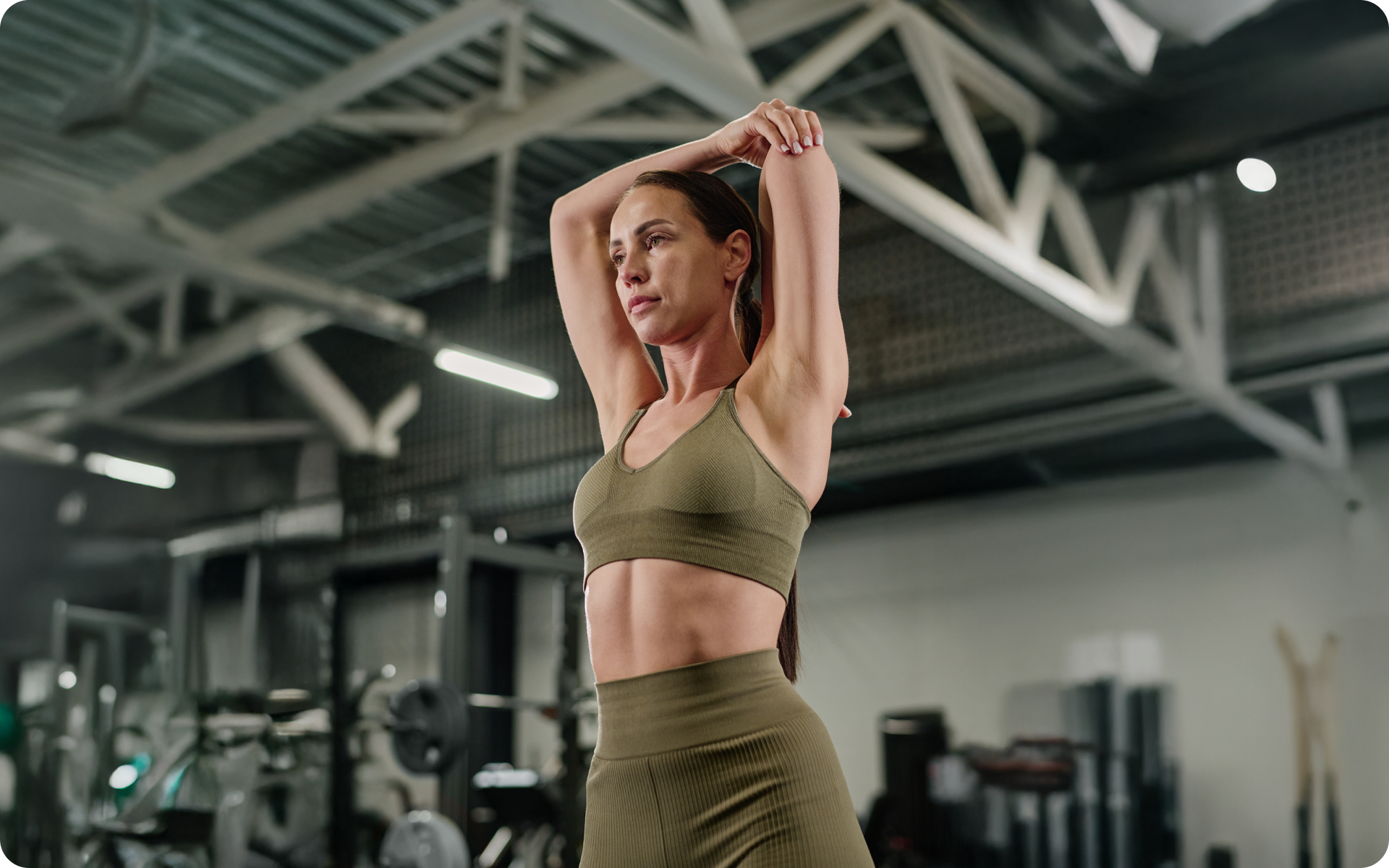If you’re already on a low-carb or keto diet, then adding in exercise can be a bit of a challenge. To get the best results from your training, it’s important to understand how a low-carb diet affects both your body and performance in the gym.
The good news is that there’s no reason why you can’t hit the gym while following a low carb or keto diet. There are some things that will affect your performance in the gym but they aren’t good reasons to stop exercising. In fact, by adjusting your workout routine slightly and making sure you fuel yourself properly before exercising, there’s a very good chance that you could see great results.
How Does Starting Keto Impact Exercise?
When you first switch to a keto diet, it’s likely that your workouts are going to feel harder. A big reason for this is because your body will only have access to carbohydrates while exercising on the keto diet.
For most people, carbs are the number one source of fuel during workouts. Without them, there’s just not enough energy for you to get through an intense workout session. That said, if you’re willing to persist with exercising when beginning your keto diet then you might soon reap some real benefits from starting this way of eating.
The biggest benefit you might potentially see is weight loss and fat loss (4). As mentioned earlier, carbohydrates are our number one source of energy when working out so when we reduce the amount of carbs in our diet, we also reduce the energy that’s available to us.
For many of us this fat loss would be beneficial to health and wellness. For those who are trying to build muscle when they exercise, it may take longer for you to see results because your body won’t have as much energy during your workouts so they won’t be as intense.
Read More: Keto Fiber Foods: 15 Low-Carb, High-Fiber Foods That Won’t Kick You Out Of Ketosis
Benefits Of Exercising In Ketosis
Keto can enhance workout performance. Here are four benefits for exercising while on the keto diet:
More Fat Burn
When you exercise, your body can burn both carbohydrates and fat for energy. If you don’t have carbs available for fuel then your body will naturally look to its fat stores to support your workout.
Blood Glucose Maintenance
Since your body is using fat as a primary source of energy during keto workouts, it also moderates blood glucose levels more easily than when it relies on carbs which create fluctuations in blood sugar levels (8).
Less Fatigue
Some people say that when they are in ketosis they don’t experience the same post-exercise fatigue that can happen with carb loading or other forms of fueling up before training.
Quicker Recovery
Some athletes have reported improved muscle recovery after working out while in ketosis, perhaps because they are using fat stores, not carbs, as the primary source of fuel (7).
BetterMe app will provide you with a host of fat-frying fitness routines that’ll scare the extra pounds away and turn your body into a masterpiece! Get your life moving in the right direction with BetterMe!
Keto-Friendly Exercises
While on a keto diet plan it’s important to keep your nutrition and workout routine in mind. When you first start out and progress through the stages of keto you can expect to feel some changes in how your body responds to both exercises and foods.
The good news is that there are plenty of ketogenic exercise choices for everyone’s needs and abilities so as long as you experiment with different ones you should be able to find an activity that works well for you.
-
Aerobic Exercise
One of the best ways to support your weight loss efforts when on a low-carb diet plan is by doing aerobic exercises. This is because aerobic exercises help put your body into an energy deficit, meaning you are burning more calories than you are taking in (3).
-
Anaerobic Exercise
Once you have mastered the ketogenic diet and feel comfortable working out, it’s time to indulge in some high-intensity workouts. These are great for building muscle mass so if that’s what your goal is then definitely consider adding them to your workout plan.
-
Flexibility Exercises
Flexibility exercises such as yoga help to reduce post-workout pain by maintaining healthy joints and muscles while decreasing stress levels (9). This can be helpful when starting a ketogenic diet or exercise routine but it also applies months down the line too.
-
Stability Exercises
One final group of exercises that can be done on a keto diet are those which target stability. These types of exercise, such as Pilates or balance training, prevent injury and increase your coordination. This can be helpful if you’re doing high-intensity workouts to build muscle mass but it’s also beneficial for beginners who may lack the neuromuscular control necessary for these types of activities.
Keto Workout Plan
Here is a sample 7 day keto workout plan for weight loss:
- Day 1: Resistance training
- Day 2: Pilates or yoga
- Day 3: High-intensity interval training (HIIT)
- Day 4: Endurance cardio, such as running
- Day 5: Flexibility exercises, such as stretching
- Day 6 & 7: Off/rest
Read More: 7-Day Keto Meal Plan: The Easy Version Of Low-Carb Dieting
The Keto Workout Meal Plan – What Should You Eat To Build Muscle?
Your keto workout meal plan should include the following foods:
Magnesium-Rich Foods
Magnesium is one of the electrolytes you’re likely to lose through sweat and urine. Dark green vegetables such as spinach, kale, and broccoli are the best sources of magnesium.
Potassium-Rich Foods
One thing that can happen when you’re on a ketogenic diet plan is that your kidneys excrete more potassium than usual. That loss can lead to fatigue and cramps during workouts (2). Many foods such as meats, fish, and avocados contain high amounts of potassium, while most fruits, vegetables, and nuts provide moderate amounts.
Sodium-Rich Foods
Replacing electrolytes like sodium is especially important for those who engage in high-intensity workouts which result in a lot of sweating. If you are trying to stay away from processed foods, you’ll get most of your sodium from the salt you add to your food, plus small amounts that are naturally present in many foods. Most of us have no problem getting enough sodium in our diets.
Proteins
Amino acids are the building blocks of protein, and they’re essential for building muscle tissue. Some amino acids are known as glucogenic because they can be broken down into glucose to fuel your body’s energy needs.
That said, you should make sure these amino acids aren’t all taken up by your muscles, leaving none left for other body functions or even the production of more proteins.
Some of the best protein sources on keto are eggs, meat, poultry, fish, avocados, low-carb dairy products like hard cheeses and heavy cream.
Fats
Don’t forget about fat when it comes to your keto workout meal plan! Dietary fats are essential for producing testosterone and boosting overall energy levels to help you perform better in the gym. They also aid in maintaining healthy skin and hair while promoting longevity in general (1). You can get dietary fat from both animal products like beef or pork, as well as plant sources like coconut oil or avocado.
The best sources of quality fats for meals and snacks include:
- Avocado oil
- Olive oil
- Butter and ghee
- Coconut oil and MCT oil
Creatine Supplements
Since your body will be using stored carbohydrates during the first few days of ketosis, it may be able to use creatine supplements to recover from the loss in its muscle tissue. Creatine may also boost exercise performance and strength, making it useful for weightlifters and those following resistance-type exercise routines (5).
To avoid side effects like bloating or nausea, start off with very small doses before moving on to larger portions like 5 grams before workouts. Always speak with your doctor first before taking any creatine supplement.
Betterme will keep you laser-focused on your weight loss journey! Nutrient-packed meal plans, fat-blasting workouts, galvanizing challenges and much more. Try using the app and see for yourself!
How Much Should You Eat To Build Muscle On Keto?
The following guidelines can help maximize your workout results while on the keto diet (6):
- Eat enough protein to sustain muscle mass.
- Get between 50 and 70% of your energy from fats.
- Make sure that 10 to 15% of what you eat is composed of carbs with a focus on high-fiber produce like leafy greens and berries.
You’ll also want to track macronutrients as part of your keto workout meal plan because this is essential for helping you reach goals. This means tracking calories as well as limiting carbs and protein while increasing fat intake to make sure they aren’t going overboard on either side.
Targeted Keto For Bodybuilding
After about a month into following a ketogenic diet plan you will have adjusted to the changes in how your body responds to workouts so at this point it may be time to start being more targeted with your eating habits and workout routines to help gain muscle mass.
The first thing you should do is track macronutrients to make sure your calorie intake is appropriate for what you’re trying to achieve. The next thing you should focus on is maximizing fat loss while preserving or even gaining lean muscle mass.
There are several ways to go about doing this but the main keys are:
- Consuming nutrient dense foods
- Ensuring ample electrolytes intake
- Getting enough protein (your muscles burn through this macronutrient first)
A targeted ketogenic diet (TKD) is one that provides between 20 and 50 grams of carbohydrates an hour before or after a workout session (10). That’s your entire daily carb allowance, but you must take it at a specific time.
It also has a ketogenic advantage. Your body can then utilize that fast glucose to enhance your workouts, allowing you to burn even more fat. When done correctly, your body burns through those carbohydrates rapidly, and you’ll be back in ketosis before you know it.
A TKD approach works best for those who have a specific exercise routine that they want to boost. This is also for those who are looking to build, tone, and define lean mass without losing too much fat.
The most important factor in your TKD plan is timing. You plan your carb intake so that your body can use that energy to have a more productive workout. Within an hour or two, you’ll be back in ketosis, burning fat again.
A targeted ketogenic diet allows you to eat carbs around workouts while still achieving ketosis with a strict low-carb lifestyle. As long as you track your macros and don’t overspend on carbs then this can be a very effective strategy for boosting performance as well as increasing protein synthesis after workouts.
How To Eat Before Exercising While Following The Ketogenic Diet Plan
If you’re interested in building muscle mass then it may be helpful to shift your keto diet plan to one that is designed for performance. You can do that by including targeted carbs before, during, and after your workout routine (10). Here are some basic guidelines on how to eat before exercising while following the ketogenic diet plan.
- Pre-Workout Snack: About an hour before your workout drink a low glycemic index (GI) carb-rich drink such as coconut water, grape juice or flavored sparkling water. This helps to replenish your glycogen stores and gives you fuel for the workout ahead without affecting ketosis too much.
- During Your Workout: One hour after drinking a low GI beverage during your workout make sure to include targeted carbs in your snack or meal. Some examples of great sources of these carbs are bananas, sweet potatoes, rice cakes or date rolls with nut butter spread on top.
- After Your Workout: It’s best to avoid eating a lot of carbs following a workout because this can cause blood sugar fluctuations which may slow recovery time and impede weight loss results later on down the line. So stick with a fat-rich snack that includes MCTs and protein to speed up recovery time and get back into ketosis.
The Bottom Line
Your glycogen stores need to be full in order to get the most out of your workout. Without carbs, keto dieters will struggle to push through intense sessions that last longer than 60 minutes. By adjusting your macronutrients around workouts you can maximize performance while still achieving weight loss results. With the tips in this article, you should be able to stay on track with your fitness goals no matter what phase of keto you might be in.
DISCLAIMER:
This article is intended for general informational purposes only and does not address individual circumstances. It is not a substitute for professional advice or help and should not be relied on to make decisions of any kind. Any action you take upon the information presented in this article is strictly at your own risk and responsibility!
SOURCES:
- A healthy approach to dietary fats: understanding the science and taking action to reduce consumer confusion (2017, nih.gov)
- A hypokalemic muscular weakness after licorice ingestion: a case report (2009, nih.gov)
- Caloric expenditure of aerobic, resistance, or combined high-intensity interval training using a hydraulic resistance system in healthy men (2015, nih.gov)
- Diet Review: Ketogenic Diet for Weight Loss (n.d., harvard.edu)
- International Society of Sports Nutrition position stand: safety and efficacy of creatine supplementation in exercise, sport, and medicine (2017, biomedcentral.com)
- Ketogenic Diet (2021, nih.gov)
- Ketogenic diet benefits body composition and well-being but not performance in a pilot case study of New Zealand endurance athletes (2017, nih.gov)
- Ketogenic Diets and Exercise Performance (2019, nih.gov)
- Stretching to prevent or reduce muscle soreness after exercise (2011, pubmed.gov)
- Your Guide to a Targeted Ketogenic Diet (2020, ketogenic.com)
















